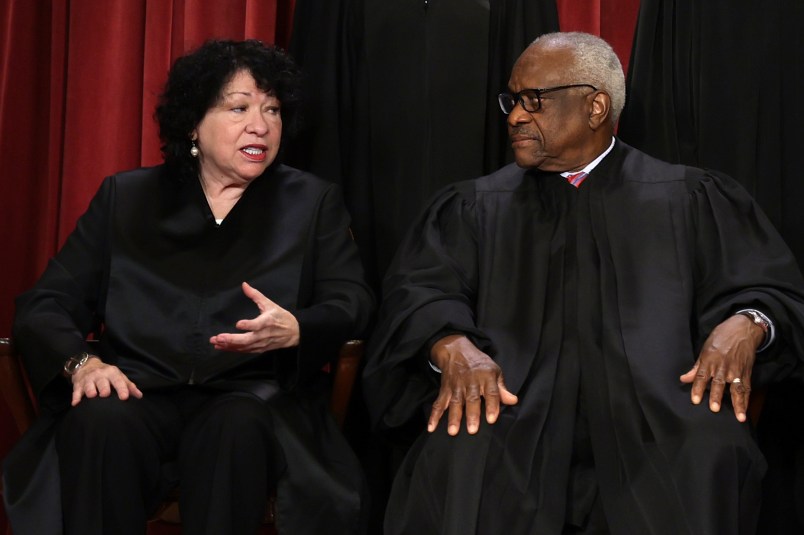Supreme Court justices often snipe at each other through footnotes and parentheticals, retorts to the “principal dissent” and respectful disagreement with their “colleagues.”
But in Thursday’s landmark decision, where the right-wing majority struck down two colleges’ race-conscious admission programs, the justices infused their opinions with an unusual degree of aggression as they called each other out by name. Every justice except Amy Coney Barrett, Samuel Alito and Elena Kagan wrote independently.
Justice Sonia Sotomayor wrote the primary dissent, taking particular aim at Justice Clarence Thomas.
“He first renews his argument that the use of race in holistic admissions leads to the ‘inevitable’ ‘underperformance’ by Black and Latino students at elite universities ‘because they are less academically prepared than the white and Asian students with whom they must compete,’” she wrote, citing Thomas’ argument in his concurrence. “Justice Thomas speaks only for himself.”
It’s not the only episode of intra-bench fire. Thomas and Justice Ketanji Brown Jackson also tangle, he from his concurrence, and she from her dissent.
“As she sees things, we are all inexorably trapped in a fundamentally racist society, with the original sin of slavery and the historical subjugation of black Americans still determining our lives today,” Thomas wrote of Jackson, adding that she seeks to “label all blacks as victims.” “Her desire to do so is unfathomable to me,” he said.
Dozens of pages away, from a footnote, Jackson struck back.
“Justice Thomas’s prolonged attack responds to a dissent I did not write in order to assail an admissions program that is not the one UNC has crafted,” she wrote, adding later: “Justice Thomas’s opinion also demonstrates an obsession with race consciousness that far outstrips my or UNC’s holistic understanding that race can be a factor that affects applicants’ unique life experiences.”
Other justices got in on the fighting too. Chief Justice John Roberts, in his majority opinion, called Sotomayor’s view of the role of the judiciary “remarkably wrong.” Gorsuch accused the liberal justices of “denying reality” in what he described as their refusal to acknowledge that race-conscious admissions programs hurt some applicants.
But one criticism may still sting more than the rest, as Sotomayor hammered more than touched a nerve. In addressing the decades of precedent her right-wing colleagues have now overturned, she accused them — the coterie perpetually insisting that they call balls and strikes, that they are nonpartisan and non-political, robe-shrouded robots who rise above the fray — of flexing the power of the conservative bloc to achieve their preferred policy outcomes.
“Lost arguments are not grounds to overrule a case,” she wrote. “When proponents of those arguments, greater now in number on the Court, return to fight old battles anew, it betrays an unrestrained disregard for precedent.”
She put an even finer point on the argument.
“At bottom, the six unelected members of today’s majority upend the status quo based on their policy preferences about what race in America should be like, but is not, and their preferences for a veneer of colorblindness in a society where race has always mattered and continues to matter in fact and in law,” she concluded.







If a pivotal % again decides to fafo, it’ll be Kagan and Sotomayor on the ‘worry list’.
Supreme Court Justices Get Unusually Personal In Landmark Affirmative Action Case
Injustice, discrimination, and inequality are personal for me too!
Seth Abramson lays it out in a thread I highly recommend.
ETA: Simply based on their public history, both Alito and Thomas appear to simultaneously be the least intellectually accomplished and the most ungracious personalities on the court.His comment on Alito is particularly perfect.